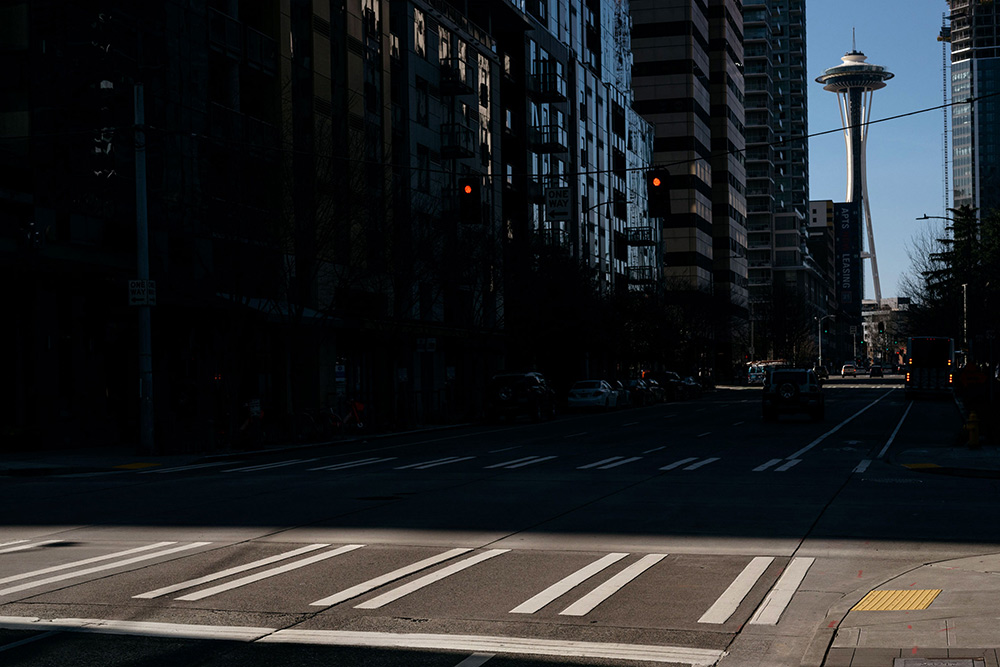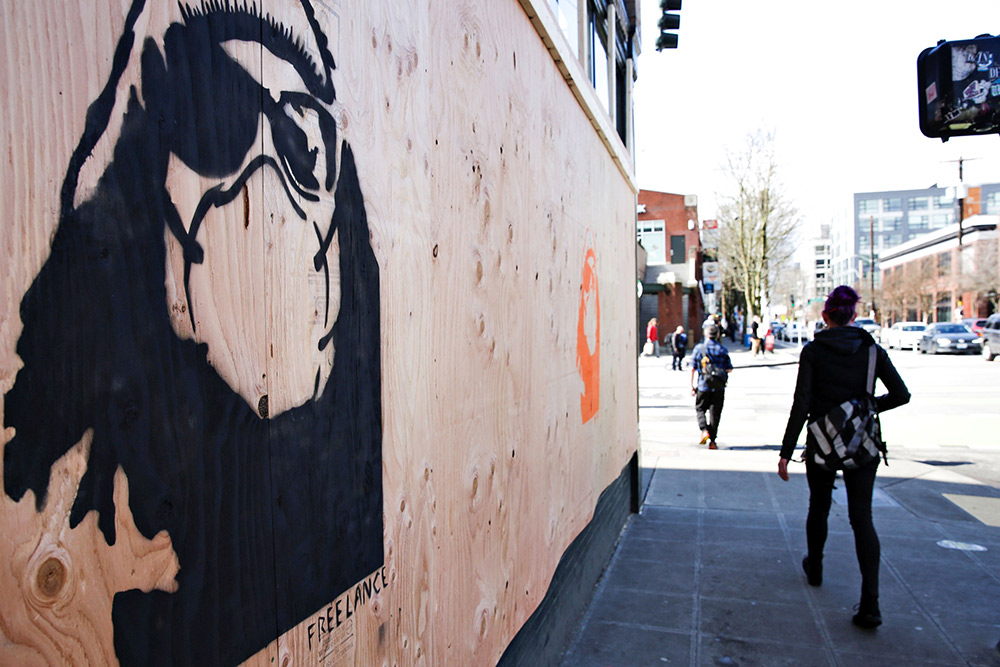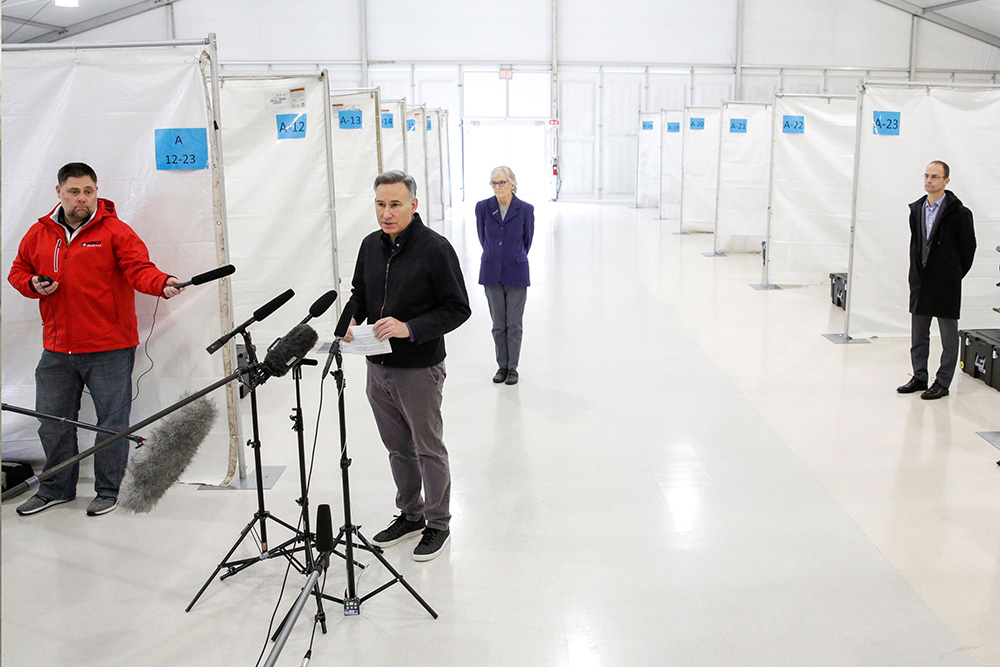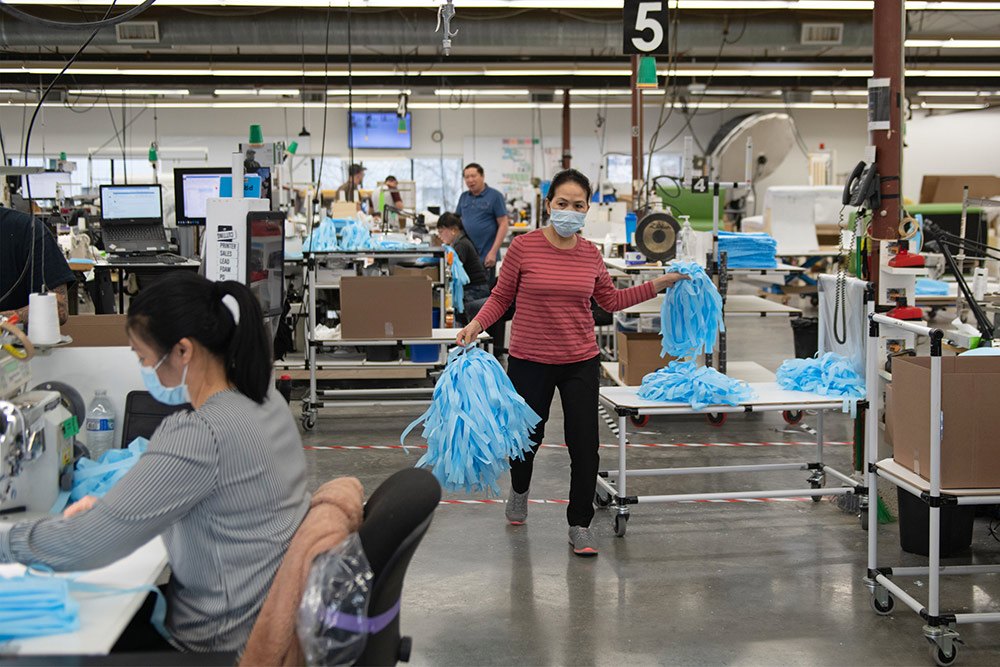汤姆·林奇并未发现世界发生变化,至少在周二上午的领导层会议上并没有预料到。他原本想谈谈2021财年的预算,没准也能趁机跟团队加深了解。那天是2月25日,林奇刚就任福瑞德·哈金森癌症研究中心主任一个月,当天早上他在大厅里走来走去,差点没有找到开会的会议室。
会议议程里,林奇还为西雅图顶尖研究机构的流行病学家特雷弗·贝德福德留了讲话时间,从1月初开始,贝德福德就一直在追踪新型冠状病毒,也就是SARS-CoV-2。林奇称贝德福德“非常谦逊”和“低调”,但当天早晨这位安静的计算科学生物学家表示西雅图的疫情状况不妙时,立刻占据了全屋人的注意力。“人们异常安静,侧耳倾听。”林奇说。“每个人立刻明白,他说的事将彻底改变大家的生活。”林奇在回忆当天情景时表示。“意识到严重性,就会印象深刻。”
对于人口350万的大都会西雅图来说,疫情到底能有多严重仍然无法完全预料。彼时,“社交疏离”尚未进入词典。西雅图人还在安排3月的技术论坛和春季筹款晚会;人们期待参加西雅图风暴队的女篮比赛、帕蒂·史密斯音乐会,还有很多人热爱的原计划在3月中旬举办的翡翠城漫画大展,10万名超级粉丝会前往参加。
当时在人们的认知里,新冠病毒似乎还是非常遥远的威胁。华盛顿州只有一例确诊病例,是西雅图郊外斯诺霍米什县的35岁男子,曾有武汉旅行史,1月中旬返美时已经感染。他接受治疗,随后康复。如果要打分,就是华盛顿1分,冠状病毒0分。然而2月下旬的那个早晨,贝德福德口中的疫情则是迥然不同的一种情景。他表示,虽然巨大风险尚未显现,但疫情蔓延相当严重。林奇明白了事情的严重性,第二天早晨,在福瑞德·哈金森癌症研究中心董事会领导层的早餐会上,林奇全盘修改了议程。

“我认为今天应该集中讨论新型冠状病毒,以及西雅图很可能要面临的问题。”林奇对董事会主席马特·麦克维恩说,他在西雅图风险投资公司Madrona Venture Group担任董事总经理。麦克维恩离开后立刻打电话给同事说:“我们要考虑一下应对策略。”
还有一人相当关注贝德福德说的数据,就是克里斯汀·格雷戈尔(绰号“克里斯”),2005年至2013年她担任华盛顿州州长,曾任福瑞德·哈金森癌症研究中心主席,现在担任“西雅图挑战”负责人,该组织联合了西雅图19家规模最大的企业和机构。其中有《财富》美国500强里众多知名企业和机构,包括亚马逊、微软、星巴克、开市客、波音、诺德斯特龙、阿拉斯加航空和比尔及梅琳达·盖茨基金会等。该组织的宗旨是解决本地教育、经济适用住房和交通方面一些棘手问题。于是,2月25日晚,西雅图挑战开了一次会。
西雅图挑战的主席苏珊·穆拉尼在华盛顿凯撒研究院担任总裁,该研究院在业内相当领先,下辖数十家医疗机构,全州超过70万名会员,也越发关注所属机构的新冠病毒防治工作。当天晚上,她花了些时间询问格雷戈尔议程,因为她认为商界应该做些准备。
回顾起来,许多与会者都认为当时的讨论是心理转折点。开会前,他们还在酒会上轻松讨论病毒;晚餐也像疫情爆发前一样围坐在桌旁。虽然有几个人近得胳膊肘都挨着,还是有不少人握了手。
“我简要介绍了预测情况会有多糟。”穆拉尼说。格雷戈尔仔细回想了贝德福德的预测。惠好公司的德文·斯托克费什、房地产估值服务提供商Zillow的里奇·巴顿,还有户外用品公司REI的埃里克·阿茨等人都将当前疫情跟1918年大流感比较,却没怎么认真重视最担心疫情的专家,即穆拉尼和最近退休的非政府卫生卫生组织PATH的首席执行官史蒂夫·戴维斯。还有一些人对美国疾病防控中心在疫情防控方面落后6到8周感到震惊。“晚餐时,所有人都感受到了危机的严重性。”总部位于西雅图的全球资产管理公司Russell Investments的首席执行官米歇尔·塞茨表示。

当晚,总部位于西雅图郊区贝尔维尤的保险业巨头Symetra Financial的负责人玛格丽特·梅斯特非常吃惊,她给领导团队发了短信。“我们得打起精神。眼前是一场危机。不是小事。”她告诉同事。
“坦率地说,人们非常震惊。”格雷戈尔说。“那天大家都意识到,如果我们不想办法控制,情势会有多可怕。”
没有人预料到疫情会发展如此迅速。仅仅三天后,公共卫生当局宣布华盛顿州确诊第二例。该病例让人震惊,因为感染者是一位当地少年、斯诺霍米什县的高中生,他哪都没去过。(他能确诊仅仅因为西雅图流感研究组织无视州政府和联邦政府指导开展了流感监测,西雅图流感研究总部位于西雅图,由盖茨风险投资公司资助,工作人员来自华盛顿大学、西雅图儿童医院,还有哈金森癌症研究中心的科学家,当然也包括贝德福德。)
第二天晚上是个星期五,格雷戈尔接到电话。华盛顿州首次出现新冠病毒导致死亡,当地一家养老院爆发疫情。病毒已经在社区蔓延,迅速传播。他们一直担心的威胁迫在眉睫。
不过另一边,疫情防控网络也在迅速布下。从研究医院和跨国企业再到全球知名机构、社区组织和政府,让西雅图紧密联系的网络正紧锣密鼓地交流信息和计划。格雷戈尔立即打电话给穆拉尼,让她准备一份简报。
如果要讲述美国第一次新冠病毒爆发也就是大西雅图地区的疫情,其实有很多方法,到本文完稿时,该地区已经有385人不幸死亡,7324人感染(在西雅图市区所在的金县,死亡人数294人,感染人数为4428人)。病毒影响了数十万人的生计。但西雅图团结一致对抗病毒的故事堪称所有城市和组织的典范。
从某些方面来看,应对新型病毒爆发方面难找到比西雅图条件更优越的城市。在公共卫生方面,西雅图鲜有对手。华盛顿大学有全美领先的病毒学实验室和规模最大的传染病部门。有影响力的流行病学家和疾病建模专家云集,从推特上20万粉丝的哈金森癌症研究中心贝德福德到华盛顿大学的克里斯·默里,很多人都得到了盖茨的资助,默里的模型还曾经被白宫借鉴。西雅图能建立全世界第一个新冠病毒备选疫苗的试验点,还在美国第一个使用家庭测试包进行病毒监测,其实并非偶然。
“我们有积攒了40年的基础设施。”拉里·科里说,他从1978年就开始在华盛顿大学从事病毒学研究项目(在开发艾滋病药物、领导哈金森癌症研究中心和领导全球艾滋病疫苗试验网络方面发挥了重要作用)。“我们能渗透到社区里……能发挥影响并成为重要因素。”

西雅图的财富同样惊人,城市里有新兴科技社区、全世界价值最高的跨国公司,还有两位顶级富豪,其中之一就是比尔·盖茨,他恰好也是最著名的流行病预防倡导者和资助者。西雅图的企业除了财大气粗,还跟遍布全球的物流、技术、生物医药专家联系紧密。
此外,西雅图的人口教育程度相当高,其中62.6%的居民拥有四年制本科学位,2019年被称为“全美受教育程度最高的大城市”,只是相对偏向数据和科学领域。(由于西雅图社交疏离做得相当好,称之为“西雅图暂停”,一些人称赞当地人身上保留的斯堪的纳维亚特质。)
通过推特上的两个标签就能看出城市的集体反应。#AllInSeattle是个筹款广告,西雅图的数十位百万富翁在四天内向各种非营利组织捐赠了2700万美元,而另一个流行标签#WeGotThisSeattle如今还放在城市标志太空针塔上。
但这并不代表西雅图已经成功脱离困境,华盛顿州州长杰伊·因斯利反复强调了这一点。但最近几周新冠病毒在美国大规模蔓延,西雅图的病例却有下降趋势,或者用流行病学家的话来说,“曲线略显弯曲”。尽管西雅图医疗资源有限,却没有像纽约和新奥尔良一样不堪重负。在西雅图及众多郊区所在的金县,确诊病例每15天增加一倍;而纽约市每11.5天增加一倍,芝加哥每8.5天增加一倍。曾经运往美国新冠爆发地的物资如今都在运往新的更严重的地区。
也正因如此,西雅图城市提供了一个样本,凸显合作的重要性。西雅图是全球性的大城市,但很多西雅图人,至少很多上层人士都会说:“感觉西雅图很像个小镇。”联系紧密的商业社区和政府各级部门之间迅速传递信息、援助和解决方案。忽然之间,之前像亚马逊和微软一样激烈竞争的公司不再忙着争夺市场份额,而是站在一起努力拯救城市。
布拉德·史密斯着实没有想到,自家后院会爆发疫情。身为微软总裁,他肯定一直在考虑病毒相关问题,2月中旬慕尼黑一场安全会议上,白宫的团队还在问他:微软在中国有何发现?中国经济低迷会产生什么连锁反应?史密斯随后前往罗马参加梵蒂冈参加活动。随着意大利北部疫情恶化,病毒成了首要考虑问题。2月28日星期五晚上,他离开意大利。
2月29日,西雅图公共卫生部门宣布了第一例新冠病毒导致死亡病例,出现在距微软办公区不远的Kirkland生命护理中心。更紧迫的是,哈金森癌症研究中心的流行病学家特雷弗·贝德福德分享了基于病毒基因组测序数据的分析,显示病毒已在社区秘密传播了数周,可能已感染数百人。历史爱好者史密斯做了两件事:首先,他买了本关于1918年流感大流行的畅销书,约翰·巴里写的《大流感》(The Great Influenza),第二是打电话给朋友格雷戈尔。第二天格雷戈尔便召集西雅图挑战成员紧急开会。他们讨论了团结私营和公共部门领导人,尤其是公共卫生专家的必要性。
第二天,格雷戈尔召开紧急会议向全体商界通报情况,后来变成了每日电话例会,有时参会者多达200人。不过格雷戈尔表示,刚开始规模小得多,只是一群领导层和金县官员梳理情况并协调应对措施,努力“建立公众信心”。
他们决定,可能的情况下各方力量都应该以同样的方式做出回应,甚至亚马逊和微软一样激烈竞争的对手也一样,无论执行居家办公政策,还是就必要员工签协议。地方或州政府官员计划宣布与疫情有关的政策时,公司也会事先收到通知。“大企业开始联合行动。”格雷戈尔说。“我在公共服务事业工作多年,从没有见过这样的情况。”
第一次电话会议召开后没几天,西雅图很多大公司都要求除了必要员工以外所有人在家办公。微软随后宣布,办公区关闭期间继续向门卫、食堂员工等小时工支付工资。亚马逊和Expedia等企业也纷纷效仿。
但病毒并没有给商业界多少时间充分研究了解,已然侵入西雅图企业界。
随着临近2月底,与西雅图的多位科技领袖一样,估值20亿美元的F5 Networks的首席执行官弗朗索瓦·洛科-多诺也计划照常工作。公司要在纽约举办投资者和分析师活动,然后3月中旬要在奥兰多召开客户年会。
但2月28日星期五晚些时候,人力资源主管把他拉到一边。当时整个华盛顿州只有3例确诊病例,但F5一名员工与其中一例与有密切接触史。该员工的病毒测试结果几天后才能知道,而他一直在上班,乘电梯,在新办公大楼48层办公。
由此引发的各种问题现在大家已经很熟悉,但在当时还都是新问题。应该关闭办公大楼吗?应该取消活动吗?会不会感染?周末,F5的领导团队在会议室里争先恐后地咨询专家并制定计划。“必须迅速决定。”洛科-多诺说。后来他们关闭办公楼彻底清洁,也或多或少迫使其他人做出决定:“我们不能再让F5的十位高管去纽约跟投资者同处一室。”他说。

尽管如此,该决定还是引发不利影响。后来员工检测结果为阴性,但最后一刻取消投资者见面会还是让市场受到惊吓,F5股价也受到重创。有几天里,“看起来是个糟糕的决定。”洛科·多诺说。当然,当时这么做是正确的,他补充说。
几天之内,其他科技公司也要处理类似的紧急决策。3月3日星期二,亚马逊给员工发电子邮件称西雅图办公区出现确诊病例。亚马逊在西雅图有5万多名员工,确诊员工在总部的巴西大楼工作,最后一次去办公室是2月25日。发病前一天晚上,该员工在附近的西雅图办公区吃了晚饭。
与此同时,Facebook的一位承包商也出现确诊病例,最后一次去办公室是2月21日。3月5日,微软的雷德蒙德办公区也出现病例,该办公区约有5万名员工。
“人们想知道确诊病例在哪层,去过哪个办公室。”微软的首席人事官凯萨琳·霍根说,她通过短信得知办公区出现确诊病例。还好微软有全球健康福利经理科伦·戴利,他拥有公共卫生领域的博士学位。每天戴利都跟美国疾控中心和世界卫生组织通电话,管理公司内部的联系追踪工作。
对西雅图的科技公司来说,为员工提供快速全面的指导相对简单,因为很多公司原本就支持新型的居家办公模式。然而对其他一些大公司来说,得失并不容易计算。
在中国疫情爆发期间,星巴克关闭了中国80%的门店。当病毒出现在西雅图时,星巴克已经具有相当丰富的经验。3月6日,西雅图市中心一家门店的员工感染,公司对商店消毒,几天后恢复了营业。其他调整也在逐步进行,例如向受影响的员工提供14天的灾难补助,还有移走店内座位。但随着各地疫情加剧,很多员工都像费城的安妮娅·约翰逊一样越发沮丧,因为得冒着健康风险提供咖啡。“这并不是必需的服务。”3月中旬约翰逊告诉《财富》杂志,几天前,她突发奇想,在网上发起请愿,呼吁疫情期间星巴克关闭门店。星巴克宣布将转为免下车自取模式时,该倡议已经吸引了37400名咖啡师和顾客的签名。(星巴克表示,做出的决定主要根据中国的抗疫经验,出于对员工和社区福利的担心,也是为了支持政府遏制病毒传播。)全美的开市客都挤满了抢购卫生纸和罐头的购物者,公司要求位于西雅图东边的总部员工正常上班。然而,开市客旅行部门一名员工死于新冠病毒,其他人在3月中旬检测呈阳性后,不再要求员工上班。
波音最大的装配工厂位于西雅图北部的埃弗雷特,有大约3.5万名员工,在普吉特湾地区雇佣了7万名员工,疫情之初还在维持正常运转。由于飞机装配是波音的核心业务,即便员工出现新冠病例,生产线组装仍然继续。直到3月下旬,一位名叫埃尔顿·华盛顿的质检员去世后,波音才暂停生产。
西雅图的企业在努力寻求平衡的同时,当地医务人员则忙于应付病人激增,还有检测等医疗用品极度短缺。早在1月,埃弗雷特的普罗维登斯地区医疗中心就接到了全国首例新冠病毒病例,为可能发生的大流行准备相关用品。
“虽然我们早计划中了几步,但挑战仍然很大。”医疗中心的首席临床官艾米·康普顿·菲利普斯说。从1月开始,由于生产线关闭,普罗维登斯在中国的供应商已经无法满足订单。普罗维登斯的工作人员找之前没有合作过的供应商,却被报价震惊,他们发现很多人是奸商,兜售的商品也不符合医疗水平。“情况太糟糕了,我们只得去Joann商店和家得宝买了一些用品。”康普顿·菲利普斯补充说。在西雅图一家本地电视台的报道中,就有普罗维登斯的护士在医院会议室自制面罩和外科口罩的画面。
Kaas Tailored公司是西雅图本地公司,有200名员工,主要为诺德斯特龙制造家具,也为波音生产飞机部件。3月18日,首席执行官杰夫·卡斯在听说物资短缺的消息后,立即给普罗维登斯的一位医生朋友发了短信:“你知道我有工厂的,对吧?”
第二天早上6点,普罗维登斯派了设计和供应小组前往卡斯在华盛顿州的马科尔蒂奥工厂。他们做出了外科口罩的原型,第二天跟荷兰一家公司合作后开始制作。卡斯在网上分享了相关规格,如今全球各地生产个人防护设备都可以参考。
卡斯的工厂里有员工、志愿者、妻子和四个孩子,此后一周六天,每天工作16小时。诺德斯特龙派裁缝去协助,还安排一位经理全职驻卡斯的工厂。如今,普罗维登斯的自救努力已经发展为由美国医院协会组织的“一亿口罩挑战赛”。
总部位于西雅图的户外和军用服装制造商Outdoor Research的老板是丹·诺德斯特龙,2002年他离开家族百货公司独立创业。Outdoor Research转型生产个人防护用品,被州长杰伊·伊斯利誉为堪比战时制造业。地方机构也加大力度,填补检测和医疗卫生领域的空白。华盛顿大学迅速组织力量,每天进行2000次测试。盖茨资助的流感研究转向利用亚马逊提供的家庭咽拭子进行新冠病毒监测。
3月中旬,一位与中国有联系的西雅图金融家联系了Madrona的麦克维恩,安排中国医生与美国同行视频通话,中方是受病毒影响的城市里的重症和急诊医生,另一边则是西雅图的医生。两天后,在哈金森癌症研究中心的帮助下,西雅图时间早上6:30在Zoom上召开了信息沟通会,全美有300人参加。
刚开始,西雅图的挑战主要是拉动企业共同行动,但随后转向排除故障和支持政府。

3月初,凯撒研究院的穆拉尼问西雅图挑战:“有人能帮忙弄基本物资吗?”开市客的首席执行官克雷格·杰利内克回应称,24小时内可以中国采购4万个N95口罩。阿拉斯加航空公司的首席执行官布拉德·蒂尔登则提出了更切实的帮助。“有一批飞机可以供你调遣。”他对穆拉尼说。
后来,华盛顿州的一位代表在电话中提到,要预付款才能确保从中国买到价值1000万美元的防护设备,当天微软就向政府提供了1500万美元。
还有个例子,微软为西雅图采购的25万个N95口罩被卡在联邦快递在孟菲斯的入境部门。3月下旬一个周六下午5点,史密斯听说后,给白宫打了个电话找国家安全委员会的联系人。第二天早上,口罩顺利过关。
“政府对企业提出任何要求,他们都站出来说:‘能做到。’”格雷戈尔说。
西雅图挑战为配送医疗用品请求援助时,找来了亚马逊和微软的高级经理。格雷戈尔说,金县改装为隔离中心的汽车旅馆需要配家具时,星巴克就送了过来。穆拉尼建议在疫情爆发期间西雅图需要一位专门人员协调医院,她的团队在约72小时内便帮州长找到了人,最后定的是曾在沙漠风暴中建立野战医院的创伤外科医生拉克尔·博诺中将。
到4月初,切实迹象表明,相关举措协助西雅图避免了情况变更糟。伊斯利州长把400台西雅图用不上的呼吸机送往东海岸。原本打算将西雅图海鹰队主场世纪互联体育场改为临时医院的物资也运往其他州。
多数地方在评估致命病毒造成的灾难性损失时,似乎只揭示出了弱点:基础设施薄弱、供应链薄弱、准备不足、政府和企业的分歧。在西雅图,疫情揭示出的仿佛是另一幅图景:几乎无人知晓的强大抗压能力。史密斯说:“如果能把大家团结起来,以正确的方式协调,就可以在一起做更多事。”
事实证明,西雅图密集的合作网络对最初遏制危机蔓延至关重要。至于是否能有效解决新冠病毒造成的次生伤害,即经济重创、失业率创纪录,以及危机暴露的不平等问题,目前尚不清楚。
种种问题都是新现实,没有简单的答案,但只要人人团结起来,西雅图的优势还是很明显。(财富中文网)
本文另一版本登载于《财富》杂志2020年5月刊,标题为《疫情中的西雅图》。
译者:Feb
汤姆·林奇并未发现世界发生变化,至少在周二上午的领导层会议上并没有预料到。他原本想谈谈2021财年的预算,没准也能趁机跟团队加深了解。那天是2月25日,林奇刚就任福瑞德·哈金森癌症研究中心主任一个月,当天早上他在大厅里走来走去,差点没有找到开会的会议室。
会议议程里,林奇还为西雅图顶尖研究机构的流行病学家特雷弗·贝德福德留了讲话时间,从1月初开始,贝德福德就一直在追踪新型冠状病毒,也就是SARS-CoV-2。林奇称贝德福德“非常谦逊”和“低调”,但当天早晨这位安静的计算科学生物学家表示西雅图的疫情状况不妙时,立刻占据了全屋人的注意力。“人们异常安静,侧耳倾听。”林奇说。“每个人立刻明白,他说的事将彻底改变大家的生活。”林奇在回忆当天情景时表示。“意识到严重性,就会印象深刻。”
对于人口350万的大都会西雅图来说,疫情到底能有多严重仍然无法完全预料。彼时,“社交疏离”尚未进入词典。西雅图人还在安排3月的技术论坛和春季筹款晚会;人们期待参加西雅图风暴队的女篮比赛、帕蒂·史密斯音乐会,还有很多人热爱的原计划在3月中旬举办的翡翠城漫画大展,10万名超级粉丝会前往参加。
当时在人们的认知里,新冠病毒似乎还是非常遥远的威胁。华盛顿州只有一例确诊病例,是西雅图郊外斯诺霍米什县的35岁男子,曾有武汉旅行史,1月中旬返美时已经感染。他接受治疗,随后康复。如果要打分,就是华盛顿1分,冠状病毒0分。然而2月下旬的那个早晨,贝德福德口中的疫情则是迥然不同的一种情景。他表示,虽然巨大风险尚未显现,但疫情蔓延相当严重。林奇明白了事情的严重性,第二天早晨,在福瑞德·哈金森癌症研究中心董事会领导层的早餐会上,林奇全盘修改了议程。
“我认为今天应该集中讨论新型冠状病毒,以及西雅图很可能要面临的问题。”林奇对董事会主席马特·麦克维恩说,他在西雅图风险投资公司Madrona Venture Group担任董事总经理。麦克维恩离开后立刻打电话给同事说:“我们要考虑一下应对策略。”
还有一人相当关注贝德福德说的数据,就是克里斯汀·格雷戈尔(绰号“克里斯”),2005年至2013年她担任华盛顿州州长,曾任福瑞德·哈金森癌症研究中心主席,现在担任“西雅图挑战”负责人,该组织联合了西雅图19家规模最大的企业和机构。其中有《财富》美国500强里众多知名企业和机构,包括亚马逊、微软、星巴克、开市客、波音、诺德斯特龙、阿拉斯加航空和比尔及梅琳达·盖茨基金会等。该组织的宗旨是解决本地教育、经济适用住房和交通方面一些棘手问题。于是,2月25日晚,西雅图挑战开了一次会。
西雅图挑战的主席苏珊·穆拉尼在华盛顿凯撒研究院担任总裁,该研究院在业内相当领先,下辖数十家医疗机构,全州超过70万名会员,也越发关注所属机构的新冠病毒防治工作。当天晚上,她花了些时间询问格雷戈尔议程,因为她认为商界应该做些准备。
回顾起来,许多与会者都认为当时的讨论是心理转折点。开会前,他们还在酒会上轻松讨论病毒;晚餐也像疫情爆发前一样围坐在桌旁。虽然有几个人近得胳膊肘都挨着,还是有不少人握了手。
“我简要介绍了预测情况会有多糟。”穆拉尼说。格雷戈尔仔细回想了贝德福德的预测。惠好公司的德文·斯托克费什、房地产估值服务提供商Zillow的里奇·巴顿,还有户外用品公司REI的埃里克·阿茨等人都将当前疫情跟1918年大流感比较,却没怎么认真重视最担心疫情的专家,即穆拉尼和最近退休的非政府卫生卫生组织PATH的首席执行官史蒂夫·戴维斯。还有一些人对美国疾病防控中心在疫情防控方面落后6到8周感到震惊。“晚餐时,所有人都感受到了危机的严重性。”总部位于西雅图的全球资产管理公司Russell Investments的首席执行官米歇尔·塞茨表示。
当晚,总部位于西雅图郊区贝尔维尤的保险业巨头Symetra Financial的负责人玛格丽特·梅斯特非常吃惊,她给领导团队发了短信。“我们得打起精神。眼前是一场危机。不是小事。”她告诉同事。
“坦率地说,人们非常震惊。”格雷戈尔说。“那天大家都意识到,如果我们不想办法控制,情势会有多可怕。”
没有人预料到疫情会发展如此迅速。仅仅三天后,公共卫生当局宣布华盛顿州确诊第二例。该病例让人震惊,因为感染者是一位当地少年、斯诺霍米什县的高中生,他哪都没去过。(他能确诊仅仅因为西雅图流感研究组织无视州政府和联邦政府指导开展了流感监测,西雅图流感研究总部位于西雅图,由盖茨风险投资公司资助,工作人员来自华盛顿大学、西雅图儿童医院,还有哈金森癌症研究中心的科学家,当然也包括贝德福德。)
第二天晚上是个星期五,格雷戈尔接到电话。华盛顿州首次出现新冠病毒导致死亡,当地一家养老院爆发疫情。病毒已经在社区蔓延,迅速传播。他们一直担心的威胁迫在眉睫。
不过另一边,疫情防控网络也在迅速布下。从研究医院和跨国企业再到全球知名机构、社区组织和政府,让西雅图紧密联系的网络正紧锣密鼓地交流信息和计划。格雷戈尔立即打电话给穆拉尼,让她准备一份简报。
如果要讲述美国第一次新冠病毒爆发也就是大西雅图地区的疫情,其实有很多方法,到本文完稿时,该地区已经有385人不幸死亡,7324人感染(在西雅图市区所在的金县,死亡人数294人,感染人数为4428人)。病毒影响了数十万人的生计。但西雅图团结一致对抗病毒的故事堪称所有城市和组织的典范。
从某些方面来看,应对新型病毒爆发方面难找到比西雅图条件更优越的城市。在公共卫生方面,西雅图鲜有对手。华盛顿大学有全美领先的病毒学实验室和规模最大的传染病部门。有影响力的流行病学家和疾病建模专家云集,从推特上20万粉丝的哈金森癌症研究中心贝德福德到华盛顿大学的克里斯·默里,很多人都得到了盖茨的资助,默里的模型还曾经被白宫借鉴。西雅图能建立全世界第一个新冠病毒备选疫苗的试验点,还在美国第一个使用家庭测试包进行病毒监测,其实并非偶然。
“我们有积攒了40年的基础设施。”拉里·科里说,他从1978年就开始在华盛顿大学从事病毒学研究项目(在开发艾滋病药物、领导哈金森癌症研究中心和领导全球艾滋病疫苗试验网络方面发挥了重要作用)。“我们能渗透到社区里……能发挥影响并成为重要因素。”
西雅图的财富同样惊人,城市里有新兴科技社区、全世界价值最高的跨国公司,还有两位顶级富豪,其中之一就是比尔·盖茨,他恰好也是最著名的流行病预防倡导者和资助者。西雅图的企业除了财大气粗,还跟遍布全球的物流、技术、生物医药专家联系紧密。
此外,西雅图的人口教育程度相当高,其中62.6%的居民拥有四年制本科学位,2019年被称为“全美受教育程度最高的大城市”,只是相对偏向数据和科学领域。(由于西雅图社交疏离做得相当好,称之为“西雅图暂停”,一些人称赞当地人身上保留的斯堪的纳维亚特质。)
通过推特上的两个标签就能看出城市的集体反应。#AllInSeattle是个筹款广告,西雅图的数十位百万富翁在四天内向各种非营利组织捐赠了2700万美元,而另一个流行标签#WeGotThisSeattle如今还放在城市标志太空针塔上。
但这并不代表西雅图已经成功脱离困境,华盛顿州州长杰伊·因斯利反复强调了这一点。但最近几周新冠病毒在美国大规模蔓延,西雅图的病例却有下降趋势,或者用流行病学家的话来说,“曲线略显弯曲”。尽管西雅图医疗资源有限,却没有像纽约和新奥尔良一样不堪重负。在西雅图及众多郊区所在的金县,确诊病例每15天增加一倍;而纽约市每11.5天增加一倍,芝加哥每8.5天增加一倍。曾经运往美国新冠爆发地的物资如今都在运往新的更严重的地区。
也正因如此,西雅图城市提供了一个样本,凸显合作的重要性。西雅图是全球性的大城市,但很多西雅图人,至少很多上层人士都会说:“感觉西雅图很像个小镇。”联系紧密的商业社区和政府各级部门之间迅速传递信息、援助和解决方案。忽然之间,之前像亚马逊和微软一样激烈竞争的公司不再忙着争夺市场份额,而是站在一起努力拯救城市。
布拉德·史密斯着实没有想到,自家后院会爆发疫情。身为微软总裁,他肯定一直在考虑病毒相关问题,2月中旬慕尼黑一场安全会议上,白宫的团队还在问他:微软在中国有何发现?中国经济低迷会产生什么连锁反应?史密斯随后前往罗马参加梵蒂冈参加活动。随着意大利北部疫情恶化,病毒成了首要考虑问题。2月28日星期五晚上,他离开意大利。
2月29日,西雅图公共卫生部门宣布了第一例新冠病毒导致死亡病例,出现在距微软办公区不远的Kirkland生命护理中心。更紧迫的是,哈金森癌症研究中心的流行病学家特雷弗·贝德福德分享了基于病毒基因组测序数据的分析,显示病毒已在社区秘密传播了数周,可能已感染数百人。历史爱好者史密斯做了两件事:首先,他买了本关于1918年流感大流行的畅销书,约翰·巴里写的《大流感》(The Great Influenza),第二是打电话给朋友格雷戈尔。第二天格雷戈尔便召集西雅图挑战成员紧急开会。他们讨论了团结私营和公共部门领导人,尤其是公共卫生专家的必要性。
第二天,格雷戈尔召开紧急会议向全体商界通报情况,后来变成了每日电话例会,有时参会者多达200人。不过格雷戈尔表示,刚开始规模小得多,只是一群领导层和金县官员梳理情况并协调应对措施,努力“建立公众信心”。
他们决定,可能的情况下各方力量都应该以同样的方式做出回应,甚至亚马逊和微软一样激烈竞争的对手也一样,无论执行居家办公政策,还是就必要员工签协议。地方或州政府官员计划宣布与疫情有关的政策时,公司也会事先收到通知。“大企业开始联合行动。”格雷戈尔说。“我在公共服务事业工作多年,从没有见过这样的情况。”
第一次电话会议召开后没几天,西雅图很多大公司都要求除了必要员工以外所有人在家办公。微软随后宣布,办公区关闭期间继续向门卫、食堂员工等小时工支付工资。亚马逊和Expedia等企业也纷纷效仿。
但病毒并没有给商业界多少时间充分研究了解,已然侵入西雅图企业界。
随着临近2月底,与西雅图的多位科技领袖一样,估值20亿美元的F5 Networks的首席执行官弗朗索瓦·洛科-多诺也计划照常工作。公司要在纽约举办投资者和分析师活动,然后3月中旬要在奥兰多召开客户年会。
但2月28日星期五晚些时候,人力资源主管把他拉到一边。当时整个华盛顿州只有3例确诊病例,但F5一名员工与其中一例与有密切接触史。该员工的病毒测试结果几天后才能知道,而他一直在上班,乘电梯,在新办公大楼48层办公。
由此引发的各种问题现在大家已经很熟悉,但在当时还都是新问题。应该关闭办公大楼吗?应该取消活动吗?会不会感染?周末,F5的领导团队在会议室里争先恐后地咨询专家并制定计划。“必须迅速决定。”洛科-多诺说。后来他们关闭办公楼彻底清洁,也或多或少迫使其他人做出决定:“我们不能再让F5的十位高管去纽约跟投资者同处一室。”他说。
尽管如此,该决定还是引发不利影响。后来员工检测结果为阴性,但最后一刻取消投资者见面会还是让市场受到惊吓,F5股价也受到重创。有几天里,“看起来是个糟糕的决定。”洛科·多诺说。当然,当时这么做是正确的,他补充说。
几天之内,其他科技公司也要处理类似的紧急决策。3月3日星期二,亚马逊给员工发电子邮件称西雅图办公区出现确诊病例。亚马逊在西雅图有5万多名员工,确诊员工在总部的巴西大楼工作,最后一次去办公室是2月25日。发病前一天晚上,该员工在附近的西雅图办公区吃了晚饭。
与此同时,Facebook的一位承包商也出现确诊病例,最后一次去办公室是2月21日。3月5日,微软的雷德蒙德办公区也出现病例,该办公区约有5万名员工。
“人们想知道确诊病例在哪层,去过哪个办公室。”微软的首席人事官凯萨琳·霍根说,她通过短信得知办公区出现确诊病例。还好微软有全球健康福利经理科伦·戴利,他拥有公共卫生领域的博士学位。每天戴利都跟美国疾控中心和世界卫生组织通电话,管理公司内部的联系追踪工作。
对西雅图的科技公司来说,为员工提供快速全面的指导相对简单,因为很多公司原本就支持新型的居家办公模式。然而对其他一些大公司来说,得失并不容易计算。
在中国疫情爆发期间,星巴克关闭了中国80%的门店。当病毒出现在西雅图时,星巴克已经具有相当丰富的经验。3月6日,西雅图市中心一家门店的员工感染,公司对商店消毒,几天后恢复了营业。其他调整也在逐步进行,例如向受影响的员工提供14天的灾难补助,还有移走店内座位。但随着各地疫情加剧,很多员工都像费城的安妮娅·约翰逊一样越发沮丧,因为得冒着健康风险提供咖啡。“这并不是必需的服务。”3月中旬约翰逊告诉《财富》杂志,几天前,她突发奇想,在网上发起请愿,呼吁疫情期间星巴克关闭门店。星巴克宣布将转为免下车自取模式时,该倡议已经吸引了37400名咖啡师和顾客的签名。(星巴克表示,做出的决定主要根据中国的抗疫经验,出于对员工和社区福利的担心,也是为了支持政府遏制病毒传播。)全美的开市客都挤满了抢购卫生纸和罐头的购物者,公司要求位于西雅图东边的总部员工正常上班。然而,开市客旅行部门一名员工死于新冠病毒,其他人在3月中旬检测呈阳性后,不再要求员工上班。
波音最大的装配工厂位于西雅图北部的埃弗雷特,有大约3.5万名员工,在普吉特湾地区雇佣了7万名员工,疫情之初还在维持正常运转。由于飞机装配是波音的核心业务,即便员工出现新冠病例,生产线组装仍然继续。直到3月下旬,一位名叫埃尔顿·华盛顿的质检员去世后,波音才暂停生产。
西雅图的企业在努力寻求平衡的同时,当地医务人员则忙于应付病人激增,还有检测等医疗用品极度短缺。早在1月,埃弗雷特的普罗维登斯地区医疗中心就接到了全国首例新冠病毒病例,为可能发生的大流行准备相关用品。
“虽然我们早计划中了几步,但挑战仍然很大。”医疗中心的首席临床官艾米·康普顿·菲利普斯说。从1月开始,由于生产线关闭,普罗维登斯在中国的供应商已经无法满足订单。普罗维登斯的工作人员找之前没有合作过的供应商,却被报价震惊,他们发现很多人是奸商,兜售的商品也不符合医疗水平。“情况太糟糕了,我们只得去Joann商店和家得宝买了一些用品。”康普顿·菲利普斯补充说。在西雅图一家本地电视台的报道中,就有普罗维登斯的护士在医院会议室自制面罩和外科口罩的画面。
Kaas Tailored公司是西雅图本地公司,有200名员工,主要为诺德斯特龙制造家具,也为波音生产飞机部件。3月18日,首席执行官杰夫·卡斯在听说物资短缺的消息后,立即给普罗维登斯的一位医生朋友发了短信:“你知道我有工厂的,对吧?”
第二天早上6点,普罗维登斯派了设计和供应小组前往卡斯在华盛顿州的马科尔蒂奥工厂。他们做出了外科口罩的原型,第二天跟荷兰一家公司合作后开始制作。卡斯在网上分享了相关规格,如今全球各地生产个人防护设备都可以参考。
卡斯的工厂里有员工、志愿者、妻子和四个孩子,此后一周六天,每天工作16小时。诺德斯特龙派裁缝去协助,还安排一位经理全职驻卡斯的工厂。如今,普罗维登斯的自救努力已经发展为由美国医院协会组织的“一亿口罩挑战赛”。
总部位于西雅图的户外和军用服装制造商Outdoor Research的老板是丹·诺德斯特龙,2002年他离开家族百货公司独立创业。Outdoor Research转型生产个人防护用品,被州长杰伊·伊斯利誉为堪比战时制造业。地方机构也加大力度,填补检测和医疗卫生领域的空白。华盛顿大学迅速组织力量,每天进行2000次测试。盖茨资助的流感研究转向利用亚马逊提供的家庭咽拭子进行新冠病毒监测。
3月中旬,一位与中国有联系的西雅图金融家联系了Madrona的麦克维恩,安排中国医生与美国同行视频通话,中方是受病毒影响的城市里的重症和急诊医生,另一边则是西雅图的医生。两天后,在哈金森癌症研究中心的帮助下,西雅图时间早上6:30在Zoom上召开了信息沟通会,全美有300人参加。
刚开始,西雅图的挑战主要是拉动企业共同行动,但随后转向排除故障和支持政府。
3月初,凯撒研究院的穆拉尼问西雅图挑战:“有人能帮忙弄基本物资吗?”开市客的首席执行官克雷格·杰利内克回应称,24小时内可以中国采购4万个N95口罩。阿拉斯加航空公司的首席执行官布拉德·蒂尔登则提出了更切实的帮助。“有一批飞机可以供你调遣。”他对穆拉尼说。
后来,华盛顿州的一位代表在电话中提到,要预付款才能确保从中国买到价值1000万美元的防护设备,当天微软就向政府提供了1500万美元。
还有个例子,微软为西雅图采购的25万个N95口罩被卡在联邦快递在孟菲斯的入境部门。3月下旬一个周六下午5点,史密斯听说后,给白宫打了个电话找国家安全委员会的联系人。第二天早上,口罩顺利过关。
“政府对企业提出任何要求,他们都站出来说:‘能做到。’”格雷戈尔说。
西雅图挑战为配送医疗用品请求援助时,找来了亚马逊和微软的高级经理。格雷戈尔说,金县改装为隔离中心的汽车旅馆需要配家具时,星巴克就送了过来。穆拉尼建议在疫情爆发期间西雅图需要一位专门人员协调医院,她的团队在约72小时内便帮州长找到了人,最后定的是曾在沙漠风暴中建立野战医院的创伤外科医生拉克尔·博诺中将。
到4月初,切实迹象表明,相关举措协助西雅图避免了情况变更糟。伊斯利州长把400台西雅图用不上的呼吸机送往东海岸。原本打算将西雅图海鹰队主场世纪互联体育场改为临时医院的物资也运往其他州。
多数地方在评估致命病毒造成的灾难性损失时,似乎只揭示出了弱点:基础设施薄弱、供应链薄弱、准备不足、政府和企业的分歧。在西雅图,疫情揭示出的仿佛是另一幅图景:几乎无人知晓的强大抗压能力。史密斯说:“如果能把大家团结起来,以正确的方式协调,就可以在一起做更多事。”
事实证明,西雅图密集的合作网络对最初遏制危机蔓延至关重要。至于是否能有效解决新冠病毒造成的次生伤害,即经济重创、失业率创纪录,以及危机暴露的不平等问题,目前尚不清楚。
种种问题都是新现实,没有简单的答案,但只要人人团结起来,西雅图的优势还是很明显。(财富中文网)
本文另一版本登载于《财富》杂志2020年5月刊,标题为《疫情中的西雅图》。
译者:Feb
Tom Lynch hadn’t expected the world to change—or at least his perception of it—at his Tuesday morning leadership meeting. He had expected to talk about the fiscal year 2021 budget and maybe to get to know his team a little better. It was Feb. 25, and Lynch was just four weeks into the job as director of the Fred Hutchinson Cancer Research Center, so new that as he walked the halls of the Hutch that morning he struggled to find the right conference room.
Lynch had also made time on the meeting’s agenda for Trevor Bedford, an epidemiologist at the prestigious Seattle-based research institute who had been tracking the novel coronavirus known as SARS-CoV-2 since early January. Lynch describes Bedford as “very humble” and “understated,” but that morning, as the quiet computational biologist laid out his grim projections for the virus’s impact on Seattle, he held the room. People became incredibly quiet and just listened,” says Lynch. “Everyone in the room at the same time got that what he was talking about was something that was going to really change our lives.” Lynch vividly recalls that day. “You remember where you were when you realized what this was.”
What this was was still a completely unfathomable proposition for most in the global metropolis of 3.5 million. “Social distancing” had not yet entered the lexicon. At the time, Seattleites were still making arrangements for March tech conferences and spring fund¬raising galas; people were looking ahead to attending Seattle Storm games and Patti Smith concerts and the Emerald City Comic Con, a beloved annual gathering of 100,000 superfans slated for mid-March.
If people knew it at all, COVID-19 was a threat that seemed at least an ocean away. The State of Washington had reported just one known case, that of a 35-year-old man from Snohomish County outside Seattle, who had traveled to Wuhan and gotten sick upon his return in mid-January. He’d been treated and recovered. For those keeping score, it was Washington–1, coronavirus–0. But on that morning in late February, Bedford framed the situation quite differently; the virus was an urgent if not yet visible existential threat. Lynch got the message, and the next morning, in a breakfast meeting with Fred Hutch’s board leadership it was Lynch who upended the agenda.
“I think we should spend this entire conversation talking about COVID-19, and what’s very likely to be coming down the pike here in Seattle,” Lynch said to his chair Matt McIlwain, a managing director at Madrona Venture Group, the Seattle-based venture capital firm. McIlwain left and immediately called his VC colleagues: “We need to think through what our strategy is,” he said.
Another person looking at Bedford’s data was Christine “Chris” Gregoire, a former Washington state governor—she served from 2005 to 2013—former Fred Hutch chair, and now head of an organization called Challenge Seattle, which engages 19 of the city’s largest businesses and institutions. Those include a striking number of name-brand Fortune 500 companies and organizations,including Amazon, Microsoft, Starbucks, Costco, Boeing, Nordstrom, Alaska Air, and the Bill & Melinda Gates Foundation, among others. The group was founded to solve some of the region’s more intractable problems surrounding education, affordable housing, and transportation. As it happened, Challenge Seattle had one of its meetings on the night of Feb. 25.
Challenge Seattle chair Susan Mullaney, the president of Kaiser Permanente Washington—which has dozens of health facilities, a leading research center, and more than 700,000 members across the state—had been following, with increasing alarm, her own group’s COVID-19 modeling efforts. She asked Gregoire for some time on the agenda that night; this was something she thought the business community needed to prepare for.
Many attendees now remember the event as their psychological turning point. Earlier in the evening, they’d casually discussed the virus over wine; at dinner, they’d sat—as one did, pre-pandemic—tightly bunched around tables. Though a few were already bumping elbows, many shook hands.
“I gave a brief update on how bad we thought it would be,” says Mullaney. Gregoire went over Bedford’s projections. As the group, which included Weyerhaeuser’s Devin Stockfish, Zillow’s Rich Barton, and REI’s Eric Artz, talked through comparisons to the 1918 flu pandemic, it was lost on no one that the most concerned among the group were its subject-matter experts—Mullaney and Steve Davis, the recently retired CEO of PATH, the global health organization. Some were struck by the assessment that the CDC was six to eight weeks behind on the issue. “The severity of it was sinking into all of us during that dinner,” says Michelle Seitz, CEO of Russell Investments, the Seattle-based global asset manager.
Margaret Meister, head of Symetra Financial, an insurance giant based in Bellevue, the Seattle suburb, had been so startled she texted her leadership team that night. “We need to up our game. This is a crisis. This is not some small thing,” she told them.
“Quite candidly, there was absolute shock around the table,” says Gregoire. “That was the day that everybody saw how dire this could be if we didn’t get to work.”
What nobody imagined was how quickly things would turn. Just three days later, public health authorities announced the state’s second confirmed case of COVID-19. It was a stunning one: The infected individual was a local teenager, a high school student also from Snohomish County but who hadn’t traveled anywhere. (His case had been detected only because the Seattle Flu Study, an influenza surveillance effort funded by Seattle-based Gates Ventures and staffed by University of Washington, Seattle Children’s Hospital, and Hutch scientists—Bedford among them—ignored state and federal guidelines and tested samples.)
And then the following night, a Friday, Gregoire got a call. The state had its first COVID-19 death, and there was an outbreak at a local nursing home. The virus was in the community, and it was spreading. The threat they’d all been worrying about had already arrived.
But something else had been spreading too. The networks that knit Seattle together—running from its research hospitals and global businesses to world-eminent institutions, community organizations, and government—were thrumming with the exchange of information and intentions. Gregoire immediately called Mullaney and asked her to prepare another briefing.
****
There are many ways to tell the story of America’s first COVID-19 outbreak—an epidemic that, in the Greater Seattle area, has to date tragically killed 385 and infected 7,324 (in King County, home to Seattle proper, the numbers are 294 deaths and 4,428 infections). The virus has stolen the livelihoods of hundreds of thousands more. But the story of how Seattle came together can be a model for any city and organization.
In some ways, it’s hard to dream up a city better equipped to manage an outbreak of a new and deadly pathogen. Seattle has few worthy rivals when it comes to public health. In the University of Washington, the city has one of the nation’s leading virology labs and one of its largest infectious disease departments. It’s a town full of influential epidemiologists and disease modelers, many of whom have had their efforts blessed with Gates dollars, from the Hutch’s Bedford—with 200,000 Twitter followers—to the University of Washington’s Chris Murray, whose models are cited by the White House. It’s no accident that Seattle has the world’s first operational trial site for a COVID-19 vaccine candidate, or that it’s the first city in the country doing COVID-19 surveillance with at-home testing kits.
“We have an infrastructure that is 40 years in the making,” says Larry Corey, the man who started UW’s virology program in 1978 (and has since been instrumental in developing AIDS drugs, helmed the Hutch, and led the global HIV Vaccine Trials Network). “We’ve been able to permeate our community…we’re able to influence and be a factor.”
Seattle is also a city of staggering wealth, home to a burgeoning tech community as well as the world’s most valuable multinational companies and the world’s two richest men, one of whom, Bill Gates, just so happens to be the planet’s most prominent advocate and funder of pandemic preparedness. Beyond those deep pockets, these enterprises are well connected to expertise—logistical, technical, biomedical—that spans the globe.
It all adds up to a highly educated population—with 62.6% of its residents holding four-year degrees, it was dubbed “America’s most-educated big city” in 2019—with a bias toward data and science. (Some also credit locals’ Scandinavian reserve—which manifests as the “Seattle freeze”—for their success at social distancing.)
Two Twitter hashtags epitomize the city’s collective response. #AllInSeattle—a fundraising banner under which dozens of the city’s millionaires donated $27 million to various nonprofits in four days—and #WeGotThisSeattle, a hashtag that trended on Twitter and was stitched on a flag that now crowns the city’s iconic Space Needle.
That’s not to say the city is out of the woods—Washington State Gov. Jay Inslee has stressed this point repeatedly—but in recent weeks as COVID-19 has continued its devastating spread across the U.S., Seattle has found a bit of a clearing, or in epidemiologist-speak, some “curve bending.” Its hospitals, though constrained by resources, have not been overwhelmed like those in New York and New Orleans. In King County, where Seattle and many of its suburbs lie, ¬COVID-19 cases today are doubling once every 15 days; that compares with every 11.5 days in New York City and every 8.5 days in Chicago. Supplies once destined for America’s ¬COVID-19 ground zero are now being rerouted to new, hotter hot zones.
In that way, the city offers a playbook, one that points to the importance of collaboration. Seattle is a big global city, but as many Seattleites will tell you—powerful ones, at least—“it feels a lot like a small town.” Information, and aid, and solutions were being rapidly passed around Seattle’s tight-knit business community and throughout the ranks of government. Suddenly some of the most cutthroat companies on the planet, like Amazon and Microsoft, weren’t trying to fight for market share, they were on the same side for once, trying to save their city.
****
Brad Smith hadn’t expected to come home to find an outbreak in his backyard. As Microsoft’s president, he’d been thinking about the virus, certainly—he’d been at a security conference in Munich mid-February, where he’d met a team from the White House who had peppered him with questions: What had the company seen in China? What would be the ripple effect of China’s economic downturn? Smith had then gone to Rome for an event at the Vatican; as the outbreak worsened in northern Italy, the virus was top of mind. He had left Italy the night of Friday, Feb. 28.
On Feb. 29, local public health authorities announced its first COVID death, an outbreak at the Life Care Center in Kirkland—a short drive from Microsoft’s campus. Adding to the urgency, Hutch epidemiologist Trevor Bedford shared an analysis, based on genomic-sequencing data of the virus, that suggested SARS-CoV-2 had been stealthily circulating in the community for weeks, likely infecting hundreds. Smith, a history buff, did two things: He ordered the best-regarded book on the 1918 flu pandemic, John Barry’s The Great Influenza, and he phoned his friend Gregoire, who had called for an emergency meeting of Challenge Seattle members the following day. They discussed the need to gather leaders from both the private and public sectors—and particularly public health experts.
The next day Gregoire held the emergency meeting, becoming the first in what is a now an ongoing series of daily COVID-19 crisis calls, open to the entire business community, sometimes with as many as 200 participants. At the beginning though, it was a much smaller group of leaders and King County officials trying to establish the facts and coordinate a response in an effort to “build public confidence,” says Gregoire.
They decided, when possible, organizations—even fierce competitors, like Amazon and Microsoft—should respond in the same way, whether it be on work-from-home policies or protocols around essential employees. Those companies also got a heads-up whenever local or state officials were planning to announce outbreak-related policies. “So these big companies began acting in concert,” says Gregoire. “I’ve had a career in public service, and I’ve never seen anything like this.”
Within days of the group’s first call, many of the city’s largest employers had asked all but their essential workers to stay home. Microsoft went on to announce it would continue to pay its hourly workers—janitors, cafeteria staff—while the campus was closed. Others, like Amazon and Expedia, followed suit.
But the virus didn’t wait for the business community to get its bearings. It had already crossed into Seattle’s corporate sector.
****
Like many of Seattle’s tech leaders, François Locoh-Donou, CEO of $2 billion F5 Networks, was planning for business as usual as February drew to a close. There was an investor and analyst event in New York, then the company’s annual customer meeting in Orlando mid-March.
But late on Friday, Feb. 28, his HR chief had taken him aside. There had been just three confirmed COVID cases in the whole state of Washington then, but one of them had been in close contact with an F5 employee. That employee—whose own COVID test results wouldn’t be available for a few days—had been coming to work, riding the elevator, and occupying space in the company’s new, 48-floor office tower.
That raised all sorts of questions—familiar now, but quite novel then. Should they close the office tower? Should they forgo their events? Had they themselves been exposed? Working out of a conference room that weekend, F5’s leadership team scrambled to consult experts and formulate a plan. “We had to make decisions really quickly,” says Locoh-Donou. They closed the tower for cleaning, a fact that more or less forced the other decisions: “We couldn’t send 10 executives from F5 Tower to be in a room with investors in New York City,” he says.
The decision hurt nonetheless. The employee tested negative, but the last-minute cancellation of the investor event spooked the market, and F5’s stock price took a beating. For a couple of days, “it looked like a bad decision,” says Locoh-Donou. Of course, he adds, it was the right call.
Within days the city’s other tech companies were dealing with similarly urgent decisions. Amazon emailed employees on Tuesday, March 3, about a confirmed case on its Seattle campus; the individual—one of the company’s 50,000-plus based in Seattle—worked out of the headquarters’ Brazil building and had last been in the office on Feb. 25. The night before falling ill, that employee had eaten dinner at Facebook’s nearby Seattle campus.
Facebook, meanwhile, had its own confirmed case—a contractor who had last been in the company’s local offices on Feb. 21. Microsoft reported a case on its Redmond campus, peopled by roughly 50,000 employees, on March 5.
“People wanted to know what floor they were on or what room they were in,” says Kathleen Hogan, Microsoft’s chief people officer, who got word of the confirmed case on their campus over text. Microsoft benefited from the expertise of Colleen Daly, the company’s global wellness benefits manager, who holds a Ph.D. in public health. Daly was on daily calls with the CDC and World Health Organization and managed the company’s internal contact tracing efforts.
For the city’s tech companies, many of which are in the business of enabling the burgeoning work-from-home economy, issuing swift and sweeping guidance for their employees was relatively straightforward. The calculation was not so simple for some of Seattle’s other large employers.
****
Having closed down 80% of its stores in China during the outbreak, Starbucks already had experience with COVID-19 when the virus showed up in its hometown. When a staff member in a downtown Seattle store came down with the disease on March 6, the company sanitized the store and resumed operations a few days later. The company phased in other changes—like offering 14 days of catastrophe pay to Covid-impacted workers and removing seating. But as the outbreak intensified across the U.S., employees like Aniya Johnson of Philadelphia grew frustrated that they were being asked to risk their health to serve coffee. “It’s not an essential service,” Johnson told Fortune in mid-March, days after she had, on a whim, started an online petition calling on Starbucks to close stores during the pandemic. The effort attracted 37,400 signatures from baristas and customers by the time Starbucks announced it was moving primarily to a drive-through model. (Starbucks says its decisions were informed by the China experience and grounded by concern about the well-being of its employees and communities, and its desire to support governments in efforts to mitigate the virus’s spread.) Costco—whose stores were deluged nationwide with shoppers seeking toilet paper and canned goods—asked employees at its headquarters, just east of the city, to report to work. That request was dropped after an employee in the company’s travel department died of COVID-19 and others tested positive in mid-March.
Boeing, which employs roughly 35,000 at its largest factory in Everett, just north of the city, and 70,000 in the Puget Sound region, initially kept its plants running. Deemed an essential business, its lines continued to assemble airplanes as COVID-19 cases cropped up in its workforce; it suspended production in the state in late March following the death of a quality inspector named Elton Washington.
While some Seattle employers struggled to strike the right balance, the area’s health care providers were scrambling to prepare for a surge of patients amid a desperate shortage of tests and other critical supplies. The Providence Regional Medical Center in Everett, which had received the nation’s first COVID-19 case in January, had tried to bulk up on supplies for a potential pandemic that month.
“Even being a couple steps ahead in our planning, it was really a challenge,” says Amy Compton-Phillips, chief clinical officer for the system. Starting in January, Providence’s orders from suppliers in China couldn’t be filled because manufacturing lines there were down. Providence staffers were overwhelmed by offers from suppliers they’d never worked with before, and came to understand many of them were profiteers, hawking non-medical-grade goods. “Things got so bad that we just went out to Joann Fabrics and Home Depot and bought supplies,” adds Compton-Phillips. A local Seattle TV station did a news story, featuring footage of Providence’s nurses assembling face shields and surgical masks in a hospital conference room.
Jeff Kaas, CEO of Kaas Tailored, a local company with 200 employees that makes furniture for Nordstrom and airplane parts for Boeing, heard about the spot on March 18 and immediately texted a doctor friend at Providence: “You know I have a factory, right?”
The next morning at 6 a.m., Providence sent a design and supply team to Kaas’s Mukilteo, Wash., factory. They worked out a surgical mask prototype, and the following day, after some collaboration with a firm in the Netherlands, they were making them. Kaas shared the specs online, which are now being used to produce personal protective equipment (PPE) around the world.
His own factory, staffed by employees, volunteers, his wife, and all four of his children, has been running 16 hours a day, six days a week since. Nordstrom has lent tailors to the effort and placed one of its managers at Kaas’s factory full-time. Providence’s effort has grown into the “100 Million Mask Challenge,” managed by the American Hospital Association.
Outdoor Research, a Seattle-based outdoor- and military-apparel maker owned by Dan Nord-strom—he left his family’s department store business in 2002—has also transitioned his operations to make PPE, an effort that was celebrated by Gov. Inslee as the sort of wartime manufacturing effort that’s needed. Local institutions have also stepped up to fill testing and health care gaps. The University of Washington has quickly ramped up its operations to run 2,000 tests per day. The Gates-backed flu study has pivoted to doing COVID-19 surveillance using at-home swab kits that Amazon delivers.
A Seattle-based financier with connections to China reached out to Madrona’s McIlwain in mid-March, offering to set up a video call between ICU and ER doctors in COVID-19-impacted Chinese cities and their counterparts in Seattle. Two days later, with the help of the Hutch, the information-sharing session took place over Zoom at 6:30 a.m. Seattle time, with 300 participants nationwide.
While Challenge Seattle initially focused on synchronizing the actions of the business community, the group’s efforts quickly turned to troubleshooting and supporting the government too.
When Kaiser Permanente’s Mullaney asked the group in early March, “Can anybody help get basic supplies?,” Costco CEO Craig Jelinek responded, saying he could source 40,000 N95 masks from China in 24 hours. Alaska Air CEO Brad Tilden made a broad offer to transport supplies. “We’ve got a fleet of airplanes that we’ll put at your disposal,” he told Mullaney.
Later, when a representative from Washington State mentioned on a call that it needed to make an advance payment to secure $10 million worth of protective equipment from China, Microsoft that day made available $15 million to the government to assist.
In another instance, a quarter-million N95 masks Microsoft had managed to procure for the state were stuck at a FedEx import facility in Memphis. Smith got wind of this dilemma at 5 p.m. on a Saturday in late March. He made a call to the White House, a contact on the National Security Council. They were released by the next morning.
“Anything the government has asked of these companies they have stood up and said, ‘We can make that happen,’ ” says Gregoire.
When Challenge Seattle asked for help organizing the state’s medical supply distribution center, they got senior managers from Amazon and Microsoft. When King County needed furnishings for motels they had turned into quarantine centers, Gregoire says Starbucks came through with furniture. After Mullaney advised that the state needed a single point person to coordinate its hospitals during the outbreak, her team helped Gov. Inslee find and hire—in roughly 72 hours—Vice Admiral Raquel Bono, a trauma surgeon who set up field hospitals in Desert Storm.
By early April, there were very real signs of hope that these types of moves had helped Seattle had escape the worst-case scenarios. Gov. Inslee sent 400 ventilators Seattle no longer needed to the East Coast. Supplies to turn CenturyLink Field, where the Seahawks play, into a temporary hospital were instead directed to other states.
In assessing the catastrophic toll from the spread of this deadly pathogen, in most places COVID-19 seemed to reveal nothing but weakness: weakness in infrastructure, weakness in supply chains, weakness in preparedness, divisions between government and business. In Seattle the pandemic seems to have revealed something else entirely: a tensile strength that few knew the city possessed. Says Smith: “If you bring us all together and coordinate the right way, you can do so much more together.”
The city’s dense web of partnerships has proved vital in stemming the initial wave of contagion; it’s unclear if it will be as effective in addressing the collateral damage COVID-19 has wrought—a devastated economy, record-level unemployment, and fissures of inequality the crisis has laid bare.
These are new realities with no easy answers, but Seattle has an advantage when everyone is #AllIn.
A version of this article appears in the May 2020 issue of Fortune with the headline “Seattle Under Siege.”






